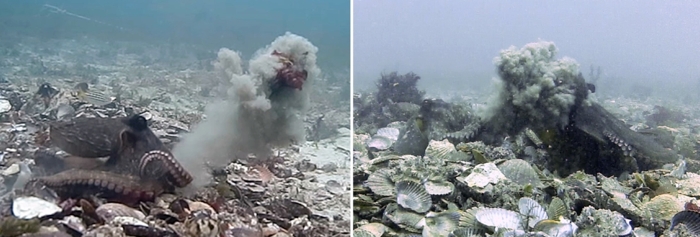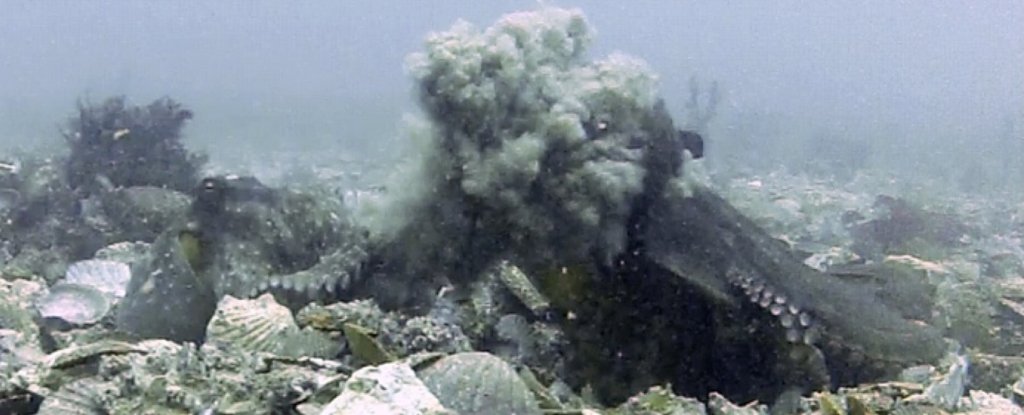Products You May Like
When it comes to getting rid of an annoying pest, sometimes subtlety just won’t cut it. Sometimes you just have to throw everything or anything within reach, pelting the offender with shells and debris until they scuttle off back to their hole.
OK, that approach probably isn’t great for humans. But for octopuses, it seems to work a treat, according to new research.
In a site off the eastern coast of Australia, where such large numbers of Sydney octopuses (Octopus tetricus) congregate that scientists have dubbed the region Octopolis, scientists first observed octopuses flinging objects at each other in a scene of heated argy-bargy in 2015.
 Debris throwing by octopuses in the wild. (Godfrey-Smith et al., bioRxiv, 2021)
Debris throwing by octopuses in the wild. (Godfrey-Smith et al., bioRxiv, 2021)
Now they have determined that the flingers are mostly female – and they’re probably, at least in some instances, trying to ward off overly amorous males.
“The throwing of material by wild octopuses is common, at least at the site described here. These throws are achieved by gathering material and holding it in the arms, then expelling it under pressure,” the researchers write in their pre-print paper.
“Force is not imparted by the arms, as in a human throw, but the arms organize the projection of material by the jet… Throwing in general is more often seen by females, and we have seen only one hit (a marginal one) from a throw by a male. Octopuses who were hit included other females in nearby dens, and males who have been attempting mating with a female thrower.”
Many animals fling debris at others, and there are many reasons for doing so. It can be a threat or defensive behavior, or have to do with trapping prey. Most animals seen doing this, however, are flinging things at other species, not their own.
So, to determine why octopuses might like to throw shells, silt, and algae at each other, a team of researchers led by philosopher of science Peter Godfrey-Smith of the University of Sydney set out to observe the chucking in action.
Using non-invasive GoPro cameras left on-site, they recorded over 100 instances of the inhabitants of Octopolis flinging debris willy-nilly. The octopuses would hold material in their arms, and then use their siphons to blast a jet of water that would blow the material up to several body-lengths away.
As they analyzed their recordings, the researchers noticed that there seemed to be two main types of throwing. The first had to do with housekeeping, and keeping their cosy dens free of unwanted debris and food waste.
The second seemed a bit more targeted. Octopuses, determined to be (mostly) female, were observed throwing material at other octopuses in targeted attacks. Overall, shells were the most commonly thrown object, at 55 recorded instances.
For 33 percent of these targeted throws, the flung object actually hit the intended target, with silt being the best material for this task. The targets were either other nearby females, or males making attempts to mate.
In one notable instance, recorded in 2016, a female octopus threw material at a male 10 times over a period of 3 hours and 40 minutes, hitting it five times. Interestingly, octopuses that were hit with such ejecta made no attempt to retaliate, but did sometimes attempt to duck (although not always successfully).
Another, perhaps slightly more controversial explanation for this behavior could be that the throws are not always necessarily targeted, but could be a form of tantrum due to frustration.
After several dramatic interactions, the researchers observed that one octopus would throw things in a manner that didn’t seem directed at the other octopus. Given how difficult it is to assign intent to animals, though, especially one as alien as octopuses, it is impossible to definitively conclude that this is the case.
Either way, it seems that the throwing does seem to play some sort of social role.
“Octopuses can thus definitely be added to the short list of animals who regularly throw or propel objects, and provisionally added to the shorter list of those who direct their throws on other animals,” the researchers write.
“If they are indeed targeted, these throws are directed at individuals of the same population in social interactions – the least common form of nonhuman throwing.”
The paper is available at the pre-print website bioRxiv.
